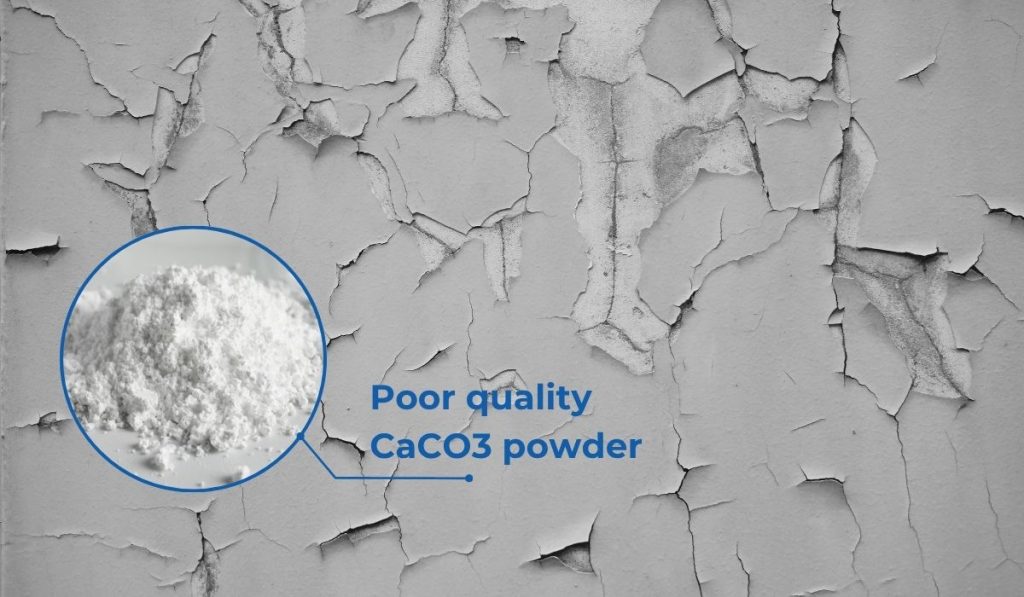Table of Contents
CaCO3 Powder for Skim Coat plays a far greater role in your product quality than many manufacturers realize.
As a manufacturer in the Philippines, have you ever faced complaints about a batch of skim coat (puting masilya) that developed hairline cracks or had inconsistent setting times during the rainy season? Before you blame the additives or workmanship, let’s investigate a silent but highly influential culprit: the quality of the Calcium Carbonate (CaCO3 Powder) you are using.
In a price-driven market, choosing a CaCO3 Powder supplier that is a few dollars cheaper per ton seems like a smart business decision. But the invisible costs from product failures, rework, and brand reputation damage are far greater. This article will expose exactly how your choice of CaCO3 Powder is quietly undermining your product’s quality.

Analyzing the Root Causes from CaCO3 Powder
Calcium Carbonate isn’t just a filler to lower costs. It is a functional component that directly impacts the physical properties of your product. Here are the three most common problems that originate from a poor CaCO3 selection.
1. Problem: Surface Cracking / Hairline Cracks
- Cause from CaCO3 Powder: Inconsistent Particle Size Distribution (PSD). When a low-cost supplier fails to tightly control the milling process, the CaCO3 powder will contain oversized and non-uniform particles. These particles act as “weak spots” within the skim coat matrix, creating internal stress and leading to micro-cracks on the surface as it cures.
2. Problem: Slow Drying & Inconsistent Performance
- Cause from CaCO3 Powder: High Moisture Content. In the humid climate of the Philippines, this is a recipe for disaster. CaCO3 Powder with high moisture content (>0.2%) not only reduces the product’s shelf life in the bag but also disrupts the cement’s hydration process. This leads to erratic setting times—sometimes too fast, sometimes too slow—creating major difficulties for applicators on-site.
3. Problem: Dull Finish & Higher Paint Consumption
- Cause from CaCO3 Powder: Low Whiteness and Brightness. A low-grade CaCO3 Powder will produce a greyish or yellowish base coat. The consequence is that the end-user must apply more coats of expensive paint to achieve the desired color. Conversely, a CaCO3 Powder with superior whiteness (>98.5%) acts as a pigment extender, creating a brilliant white base that significantly saves on paint costs.
The Solution: 3 Questions You Must Ask Your CaCO3 Powder Supplier
Don’t be tempted by a $5-$10/ton discount. Protect your product’s quality by demanding transparency from your supplier.
- “How do you control Particle Size Distribution (PSD) to ensure consistency between batches?” – A reputable supplier should be able to provide you with a PSD chart.
- “What is the guaranteed moisture content of your product, and what is your control process?” – The number must be clear and guaranteed (<0.2%).
- “What is the range of your product’s whiteness and brightness, and is it consistently maintained?” – Ask for the Quality Control (QC) results from their recent batches.
The Global Minerals Guarantee: Stability is Our Core
At Global Minerals, we don’t compete on the cheapest price. We compete with stability that has been proven for over 20 years.
- We solve the cracking problem with advanced milling technology that guarantees an exceptionally consistent PSD.
- We solve the setting time problem with a stringent drying system and QC process, ensuring moisture is always at an optimal level.
- We help you save on paint costs thanks to our self-owned quarries that provide a source of limestone with superior natural whiteness.
Don’t gamble your peak production season on an unreliable raw material supplier. Choose a strategic partner who helps protect your quality and your reputation.
To help you make a data-driven decision, we have prepared a detailed technical specifications guide.
Download The Full Technical Guide Here
Or watch Expert Insights: Unlocking the Power of CaCO3 Powder
Ready to verify the difference for yourself?
Request a Trial Sample for Your Formulation



